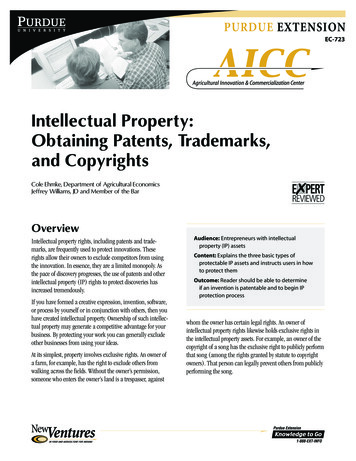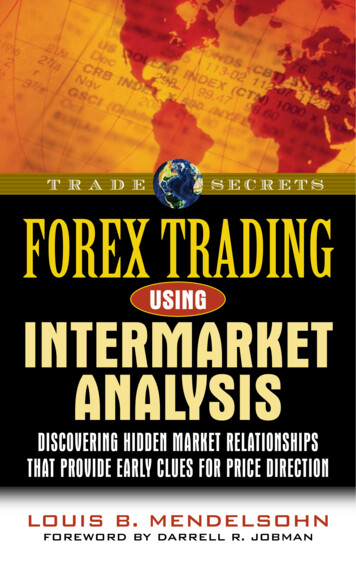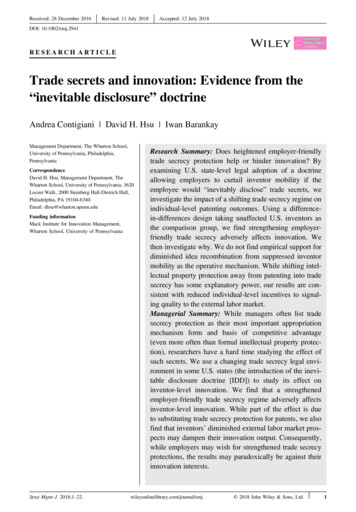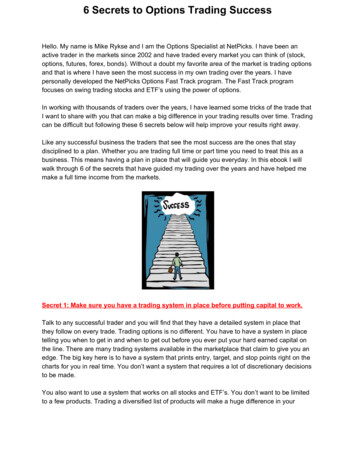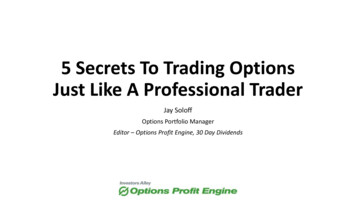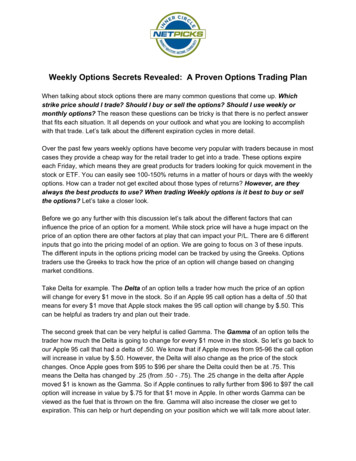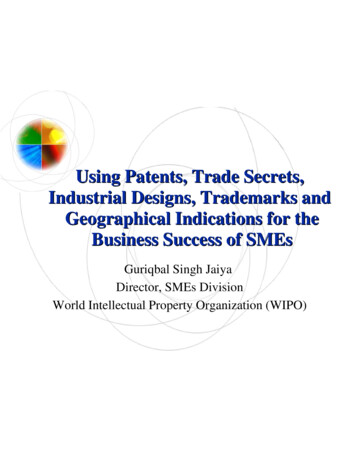
Transcription
Using Patents, Trade Secrets,Industrial Designs, Trademarks andGeographical Indications for theBusiness Success of SMEsGuriqbal Singh JaiyaDirector, SMEs DivisionWorld Intellectual Property Organization (WIPO)
What makes a productsuccessful? Product represents a functional improvementcompared to other existing products Advantageous price Product or its package has an attractive design The brand of the product has a good reputation(guarantee for quality) and has been promoted throughpublicity Product can easily be found in the main retail placesand is distributed by the main distributors Good after-sale services
Legal protection of IPgrants exclusive rights Innovation - improvementof functional aspects orfabrication process of theproduct Design - the product’sappearance Brand - commercialization /marketing of the productPatents, UtilityModelsIndustrial DesignsTrademarks
Limits on Patents Limited in time: protection for max 20 years. Afterthat, they may be commercialized without authorization– In Europe less than 25% of the patents are upheld for20 years Limited in content: a patent only protects what isspecified in the claims Geographical: a patent is only valid in thecountry/countries where protection is granted
A range of IP can be used toprotect the same productExample: Fountain pen Patent: for the fountain penthat could store ink Utility Model: for the grip andpipette for injection of ink Industrial Design: smartdesign with the grip in theshape of an arrow Trademark: on the productand/or the packaging todistinguish it from other pens Source: Japanese Patent Office
Regardless of what product your enterprisemakes or what service it provides,it is likely that it is regularlyusing and creatinga great deal of intellectual property
IP rights can be acquired for Name of the business : Trade Name Distinctive signs: Trademarks, Geographical Indications,Certification Marks, Collective Marks Creative designs (appearance or look of the products):Industrial Design Innovative products and processes: Patents, Utility Models Cultural, artistic and literary works, including (in mostcountries) computer software and compilation of data:Copyright Confidential business information (customer lists, salestactics, marketing strategies, manufacturing process, etc.):Trade Secrets
Example: Lego 1934 - Trademark: Leg Godt(“play well”) 1958 - Patent: stud and tubecoupling system (the waybricks hold together) 1974 - Industrial Designs:lego figures: castles, pirateships, Wild West ranches,cavalry forts, space stations,people Copyright: artistic work,manuals
How can IP ‘add value’to your business?(1)(2)(3)(4)(5)Increasing market value of the firmMarketingExporting goods and servicesRaising financesAcquiring new technology and findingsuppliers(6) Commercializing innovative products
(1) IP can increase the market valueof a business IP may generate an income for your SME– Exclusive rights to use and exploit (for limited time) prevent others from commercially using your creations– Licensing, sale (patents, trademarks, industrial designs,know-how, copyright)– Cross-licensing: using IP as a negotiating tool toobtain licenses from other companies
(1) IP can increase the market value IP rights can enhance the value of your SME in theeyes of investors and financing institutions– IP rights are one of the 5 main criteria used by Europeanventure capitalists in their decisions to fund SMEs In the event of a sale, merger or acquisition, IPassets can provide an extremely valuable bargainingtool IP assets are separately identifiable business assetsand have a separate value– E.g. Coca-Cola brand value: estimated at US 69 billion
Examples Biobrás: A Brazilian biotech company obtained apatent on human recombinant insulin. While saleshave remained constant (company exploringcommercialization), the value of shares has gone upsix-fold over the past 5 years. Amati Communications (US): Texas Instrumentpaid US 395 million to acquire a small computercompany (Amati Comm.). The reasons for such ahigh price were 25 key patents.
(2) IP is an important marketing tool“Marketing is everything you doto promote your business,so thatcustomers buy your products or servicesand begin to patronize your businesson a regular basis”
IP rights are crucial for (1) Differentiating your products/ services and makingthem easily recognizable– Industrial designs & trademarks are identifiers ?customers distinguish, at a glance, between yourproducts or services and those of your competitors.They establish a link between your products orservices and your SME Promoting your products or services and creating aloyal clientele– Trademarks, geographical indications, collectivemarks, certification marks ? customers associate themwith certain desired qualities
IP rights are crucial for (2) Creating a distinct image for your business in theminds of your customers and in positioning yourbusiness in the market– Trademarks, trade names, industrial designs, patents Marketing your products or services in foreigncountries Marketing your products in the new economy– Use of domain names and trademarks in e-commerce
(3) Exporting Goods and Services IP rights are ‘territorial’ SMEs that intend to export their products shouldconsider legal protection of their IP in theirexport markets in order to have exclusivity Whether you commercialize yourself or license In time!
(4) Raising FundsTwo ways of raising funds:– Debt - loan which the borrower must repay– Venture - which gives the investor a share of theactual business of the investee and is notautomatically repaid by the investee business, butrather relies on the investor ultimately realizingthe equity held in the business
4.1 Debt Finance Debt finance is generally ‘secured’ by a charge over thebusiness’ assets. In principle, these assets can be any claimsthat have reasonably predictable cash flows, or even futurereceivables that are exclusive. Securitization of IP assets - a new trend: collateralizingcommercial loans and bank financing by granting a securityinterest in IP is a growing practice, esp. in music, Internetand high technology sectors.– E.g., securitization for future royalty payments from licensinga patent, trademark or trade secret, or from musicalcompositions or recording rights of a musician (D. Bowie).
4.2 Venture Capital For the venture capitalist, return depends uponfuture profits. IP ownership is important to convince investorsof the market opportunities open to the enterprisefor the commercialization of the products orservices in question :
Convince Venture Capitalist (1)– Strong trademarks are a guarantee for a loyalclientele– Patents and industrial designs provide exclusivityfor the commercialization of inventions resp.attractive designs ? may be important to convinceinvestors for the commercialization of your product– Patents may convince investors that your product isinnovative, unique, or superior to the offerings ofcompetitors
Convince Venture Capitalist (2)– Trade names, trademarks and domain names may bethe prime elements that differentiate your productfrom those of competitors– For many companies, trade secrets (such as details ofproduction, secret inventions, and technical, financialand marketing know-how) alone may be the source oftheir competitive advantage
Therefore Ensure that your IP portfolio protects those aspectsof the business which determine the venture’ssuccessReflect proprietary IP in your business’ books,balance sheet, business planAny indication that confirms due diligence on yourpart in the management of IP assets is likely to playan important role in convincing investors of yourcompany's potential
(5) Acquiring New Technology &Finding Suppliers SMEs seeking access to innovative technology developedby other companies should consult patent databases toidentify the necessary technology. They may have to negotiate licensing agreements with thepatent holder in order to obtain the right to use thetechnology. Information in patent documents may also assistentrepreneurs in their search for alternative suppliers ofidentical or similar technologies.
Patent Information:Other Side of the Coin Patent? 1. “deed securing to a person an exclusiveright granted for an invention”? 2. “open, evident, manifest”; “open to publicperusal” Latin patens(Collins Dictionary) Patent as an interchange between society and the inventor All patents are published and are open to public
What is Open to the Public? “Patent information” is the technical and legalinformation contained in patent documents that arepublished periodically by patent offices. A patent document includes the full description of howa patented invention works and the claims whichdetermine the scope of protection as well as details onwho patented the invention, when it was patented andreference to relevant literature.
Relevance of Patent DocumentsTechnological relevancePatent informationLegal relevanceCommercial relevance
Using Patent InformationLegal relevance: Avoid possible infringement problems Assess patentability of your own inventions Oppose grant of patents wherever theyconflict with your own patent
Using Patent InformationTechnological Relevance: Keep abreast with latest technologies in yourfield of expertise Avoid unnecessary expenses in researching whatis already known– “Discovery consist in seeing what everybody has seen, andthinking what nobody has thought” (Albert Szent-Györgyivon Nagyrapolt)– In Europe, more than US 30 mill. per year is waisted inunnessary research - 30% of the total investment in R&D
Using Patent InformationTechnological relevance: Identify and evaluate technology for licensingand technology transfer Get ideas for further innovation Identify alternative technologies Find ready solutions to technical problems
Using Patent InformationCommercial Relevance Locate business partnersLocate suppliers and materialsMonitor activities of competitorsIdentify niche marketsUse what is allowed to use (limits of patents)
Using Patent InformationDid you know? The entire set of patent documents worldwide includesapproximately 40 million items. Every year approximately 1 million patent applications arepublished. About two-thirds of the technical information revealed inpatents is never published elsewhere.
Using Patent InformationDid you know? Most of the inventions are disclosed to the public for thefirst time when the patent is being published. The information contained in the patent documents ISNOT SECRET!
Thomas Edison:“I start where the last man stopped”
(6) Commercializing Innovative Products An invention on its own has little value for anSME ? How do you turn inventions intoprofit-making assets of your SME? Trade secret vs. Patent - The acquisition of apatent gives the SME exclusivity over thecommercialization of an innovative product orthe innovation process of fabrication– either: commercialize the invention yourself– or: allowing its commercialization by others
Commercializing Innovative Products (2) If you choose not to exploit the patent yourself ? you may-sell orlicensethe rights to other firms that have the capacity tocommercialize the patented inventions A licensing agreement is a partnership between an IP rightsowner (licensor) and another who is authorized to use suchrights (licensee) in exchange for an agreed payment (fee orroyalty)
Advantages of Licensing Technology you can ensure a steady stream of additionalincome from your invention (royalties) no need to invest yourself in the commercializationof the invention your SME can expand its business to the frontiersof your partners' business cross-licensing
Cross-licensing: example Dell (computer company) has number of patents in theUS on its unique business models In 1999, Dell used its patent portfolio as collateral in aUS billion cross-licensing deal with IBM with lowercost computer components This freed Dell from having to pay IBM severalmillions of dollars in royalties
Attention !International context? IP right you wish tolicense must be protected in the countriesconcerned.License agreement: written record in registerChoose the right partner
Commercializing innovative productsExample: ring-pull cans The inventor licensed the system to Coca-Cola at 1/10 of apenny per can. During the period of validity of the patent theinventor obtained 148,000 UK pounds a day on royalties.
Commercializing innovative productsExample: Post-it The glue used for Post-its was discovered by chance by 3M.Initially ignored, it was then patented. Post-its subsequentlybrought huge profits to the company through licensingagreements.
Some key strategies1.IP audit: taking stock of all IP (how is itcurrently exploited?)2.IP valuation: like physical assets, IP assetsshould be identified and valued individually (as astand-alone asset) important for licensing, during M&As, for raisingfunds, to report to shareholders and investors3.4.Licensing: may provide a constant revenuestream from royaltiesCross-licensing: using IP to obtain accessto other companies’ technology
Some Key Strategies5.Announce your IP: let potential investors,lenders, business partners, share holders, etc.know that you have proprietary IP. Include IP assets in accounts books, balance sheet,business plan6.regularIP search: consult IP databases on abasis.
ConclusionBy establishing a culture ofidentifying, cultivating and strategically usingits IP assets,an enterprise can increase its revenue,have an edge over its competitorsandposition itself well in the market.
Trade Secrets Definition: Any confidential business information whichprovides an enterprise a competitive edge may be considereda trade secret Examples: sales methods, marketing strategies, innovativemanufacturing process, lists of suppliers, new products orservices, financial information Famous examples: Coca-Cola formula, Microsoft’s sourcecode for Windows Every company has its trade secrets. Information that it doesnot want competitors to know about. Trade secrets are also intellectual property !
How to protect trade secrets? No need for registration. But 3 essentialrequirements:– The information must be secret !– It must have commercial value because it’ssecret– It must have been subject to reasonable steps bythe holder to keep it secret (e.g. confidentialityagreements)
Trade secrets vs. Patents Advantages of trade secrets:––––No need to registerNot limited in timeNo disclosureCan protect unpatentable information Disadvantages of trade secrets:––––Costs of keeping it secret can be highOthers may discover/invent it independentlyOthers may patent it (if patentable)If the secret is embodied in a product it may bereverse engineered– More difficult to enforce
Trade secrets or patents?Suppose: An SME develops a process for the manufacturing of itsproducts that allows it to produce its goods in a morecost-effective manner. The process is not sufficiently inventive to be protectedby a patent, but it provides the enterprise a competitiveedge over its competitors. The enterprise in question may therefore value itsknow-how as a trade secret and would not wantcompetitors to learn about it.
Trade secrets or patents? 1958 : Patent for stud and tubecoupling system (the way brickshold together) But: Today the patents have longexpired and the company trieshard to keep out competitors byusing designs and copyright
Trade secrets or patents? Case-by-case basis Trade secret protection may be advisable :– For inventions or manufacturing processes that do notmeet the patentability criteria and therefore can only beprotected as trade secrets (though they may qualify forprotection as a utility model)2. When the trade secret is not considered to be of suchgreat value to be deemed worth a patent (though utilitymodel may be good alternative)
3.keptWhen it is likely that the information can besecret for a considerable period of time. If the secret information consists of a valuable patentableinvention, trade secret protection would only be convenientif the secret can be kept confidential for over 20 years(period of protection of a patent) and if others are not likelyto come up with the same invention in a legitimate way.4.When the secret relates to a manufacturingprocessrather than to a product, as productswould be morelikely to be reverse engineered.5.When you have applied for a patent and arewaitingfor the patent to be granted.
However, bear in mind:– Trade secret protection is generally weak– The courts may require very significant andpossibly costly efforts to preserve secrecy– Patent/utility model protection will provide muchstronger protection– Patent/utility model may reveal a lot of valuableinformation, but at the same time, it providesexclusivity in the marketplace
Strategies for ProtectingTrade Secrets Consider whether the secret is patentable and, if so,whether it would not be better protected by a patent Make sure that a limited number of people know thesecret and that all those who do are well aware that itis confidential information Include confidentiality agreements withinemployees’ contracts Sign confidentiality agreements with businesspartners whenever disclosing confidentialinformation
IP and Marketing How to make my product easily recognizable?– Create a distinct identity through industrialdesigns and trademarks How to develop trust and confidence in myproducts?– Refer to reputation and certain qualities in theproduct through collective marks, certificationmarks, geographical indications
Industrial Designs Industrial designs are compositions of lines orcolors or any three-dimensional forms which givea special appearance to a product They protect the ornamental or aesthetic aspectof a product (not functional) Exclusive rights: Right to prevent others fromapplying (making, selling or importing) theprotected design to commercial products for aperiod of 10 to 25 years (Estonia: 25y) Requirement of registration (new EU legislationincludes unregistered design protection)
What is a Good Design?Legal point of view: appeal to the eye (e.g. shape of toothbrush)useful articlenew or originaldesign should not be dictated by functional ortechnical necessity (handle brush) must be reproducible by industrial means
What is a Good Design? (2)Business point of view:– Make your product appealing to consumers– Customize products in order to targetdifferent customers (e.g. Swatch)– Develop the brand image (e.g. Apple’s"Think Different" strategy)
Trademarks A trademark is a distinctive sign which identifiescertain goods or services as those produced orprovided by a specific person or enterprise Exclusive rights: To prevent others from usingidentical or similar marks on identical or similargoods in respect of which mark is registered
What is a Good Trademark?Legal point of view: Distinctive : allow to distinguish goods andservices from those of another company Signs eligible for registration:– words (including personal names)–––––lettersnumeralsfigurative elementscolorsany combination of the signs mentioned
Bars for Registration:– Generic (too descriptive) E.g. “chair” for chairs; “sweet” for chocolate– Contrary to morality or public order– Misleading (as to the nature of goods, source,characteristics, or suitability for the purpose) E.g. “wool”– State emblems E.g. National Flag– Existing third party rights ? trademark search
What is a Good Trademark?Business point of view:– sufficiently distinctive– easy to read, spell, memorize and pronounce– suitable for export markets (no adversemeaning in foreign languages) (e.g. Pajero)– fit the product or image of the business– have no legal restrictions– have a positive connotation
Possible Categories1.Fanciful words: invented words without any real meaning inany language (e.g. Kodak or Exxon)Pos: easy to protect (likely to be considered distinct)Neg: difficult to remember ? greater efforts in advertising2.Arbitrary marks: words that have a real meaning in a givenlanguage. This meaning, however, has no relation to the productitself or to any of its qualities (e.g. Apple)Pos: level and ease of protection is generally highNeg: no direct association between the mark and the product? greater marketing power to create such an associationin the mind of the consumer
3.Suggestive marks: marks which hint at one or some ofthe attributes of the product (e.g. Benecol, Bonaqua)Pos: act as a form of advertising and may create a directassociation in the mind of the consumers betweenthe trademark, certain desired qualities and theproductNeg:Risk too descriptive or not sufficientlydistinctiveto meet the legal criteria fortrademark protection
How to Protect a Trademark? Registration is required in most countries(except well-known trademarks). Trademark search : To be sure that it is notregistered by another company in the country for thesame products (goods or services). It is important to register early, and in any casebefore launching a new product on the market
How to Protect a Trademark? Territorial : only protected in the country in whichregistration has been obtained Term : 10 years – renewable indefinitely ! Some countries: obligation to use (3 or 5ynon-use ? invalid) Does not protect any feature of the product itself
How to take full advantage of a trademark? Register your trademark as soon as possible. Monitor the market and be sure that no oneinfringes your trademark rights. Use your trademark in publicity and marketingcampaigns. Consider licensing and franchising License ? be sure that the quality is maintained
Example: “Artesanía Latina”boats,-word figurative element-Spain ? CTM (registered with the OHIM)-for toys, especially “maquettes” (sailingwooden cars, teddybears, etc.)
Collective Marks Signs which distinguish the geographical origin,material, mode of manufacture, quality or othercommon characteristics of goods or services ofdifferent enterprises using the collective mark Typically, the owner is an association of whichthose enterprises are members
Collective Marks The owner is responsible for ensuring compliancewith certain standards by its members. Thus, the function of the collective mark is to informthe public about certain particular features of theproduct for which the collective mark is used. Often used to promote products which arecharacteristic of a given region. In such cases,collective marks may also provide a framework forcooperation between local producers.
Example: “Interflora”orden-international chain; used all over the world toand send flowersmore than 70.000 flower shops in 150 countriesflowersflowerthe emblem of Interflora is Mercurius, baringas a symbol of the service that the associatedshops provideit withthe slogan of the organization is the famous “Sayflowers".
Example: “Cajamarca” (Peru)
Certification Marks usually given for compliance with certainstandards not confined to any membership may be used by anyone who can certify thatthe products involved meet certain establishedstandards.
Example: “Max Havelaar”– owned by the Max Havelaar foundation– each producer/importer of coffee, chocolate, tea,honey, bananas or oranges can be considered asa potential license holder– they have to comply with certain conditions oftrade
Example: “Tooth friendly”– appears on the packaging of foodstuffs– certifies that its ingredients do not producecavities and thus are not bad for your teeth
Example: “Woolmark”– registered by the Woolmark Company– a quality assurance symbol denoting that theproducts on which it is applied are made from 100%wool and comply with strict performancespecification set down by the Woolmark Company– registered in over 140 countries
Geographical Indications A sign used on goods that have a specificgeographical origin and possess qualities or areputation that are due to that place of origin Most commonly, a geographical indication consists ofthe name of the place of origin of the goods– E.g. Champagne In some countries (incl Estonia): can also be figurativeelement– E.g. Eiffel tower
Agricultural products typically have qualities thatderive form their place of production and areinfluenced by specific local factors, such as climateand soil (e.g. cheese) In Azerbaijan:– no owners– perpetual protection– registration
Example: “Talavera de Puebla”- Considered to be one of the finest ceramics in Mexico- Handmade and painted by hand- Historical linked with Arabic culture- Typical are the geometric designs in blue color painted on awhite background- The designe and colors of the artwork are created followingtraditional rules and knowhow
Examples––––––Champagne, Sherry, Porto, Scotch WhiskyBulgarian yoghurtPilsen, BudweisEgyptian CottonTuscany (olive oil Italy)Roquefort (cheese France)
Geographical Indications Inherent in certain products from a particular regionare characteristics that are due to the soil, climate orparticular expertise of the people of that area whichconsumers expect and have confidence in Capitalizing on that reputation for your products thatemanate from such area or benefit from such skills inyour marketing strategy makes sound business sensein differentiating your products from those of others. But ! You SME must maintain the standards andquality expected
Message for SMEs:If you can’t beat them, join them One of the greatest challenges for SMEs is not somuch their size, but their isolation. Difficulties faced by SMEs acting individually togain recognition for their goods or services in themarketplace. Working collectively, SMEs can benefit from theadvantages of collective strengths.
WIPO’s website:http://www.wipo.intWIPO’s website for SMEs :http://www.wipo.int/sme
Trade secret vs. Patent -The acquisition of a patent gives the SME exclusivity over the commercialization of an innovative product or the innovation process of fabrication – either: commercialize the invention yoursel

